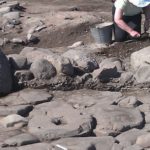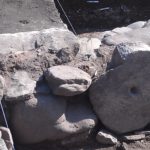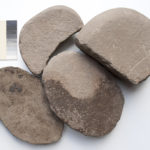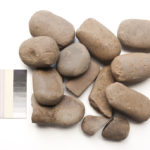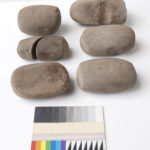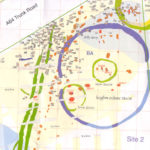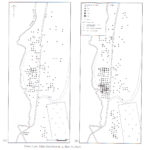This is a great Community Archaeology Project run by Mary Peteranna and Steve Birch. Medieval Cromarty is being rediscovered with the help of volunteers of all ages. Ceramics, mammal and fish bones, and a number of intriguing stone discs have been recovered already. The rotary querns in the photographs were placed in walls and floors of the buildings. For more information go to http://www.medievalcromarty.org
Author: Ann
Expanding Horizons: Raw material use during the Late Mesolithic at Stainton West, Carlisle, Cumbria
An incised Mesolithic bevelled pebble from Scotland
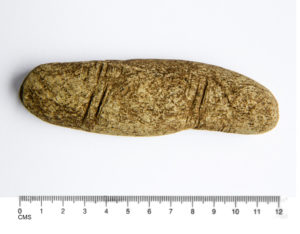
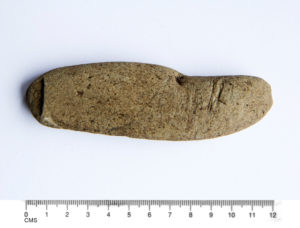
During recent excavations at Camas Daraich, Skye an incised bevelled pebble was discovered at the base of a midden layer dating to the Mesolithic . Finds of incised or decorated stone and bone from this period are rare in Britain as a whole and this is the first of its kind from Scotland.
This is a classic elongated pebble form with a double bevel worn on the broader end and with some flaking from this end too. The bevels abut to form a ridge which runs at an angle to the faces. The pebble has a naturally shaped ‘handle’ which is a third of the total length of the tool. The incised pattern is formed of pairs of narrow, parallel bands which divide the tool obliquely into thirds. For a 3D image of this tool check:
There are many possible interpretations for the presence of the incised lines on this stone tool. It is clear that the incisions are deliberate and composed but it cannot be determined yet whether they are, for example, purely functional, a deliberate abstract representation, a recording or message. A full discussion of the meaning behind the incisions is in:
Clarke, A; Vila, A; Estevez, J; Hardy, K 2012 ‘The Tie That Binds? An incised Mesolithic bevelled pebble from Camas Daraich, Skye’ Mesolithic Miscellany 22.1, October 2012, 3-9. https://sites.google.com/site/mesolithicmiscellany/journal-information/journal-volumes
Stone tools from an Early Iron Age souterrain at Windwick, South Ronaldsay, Orkney
A fine assemblage of stone tools including saddle querns, quern rubbers and cobble tools was found during recent excavations at Windwick by Martin Carruthers, University of the Highlands and Islands.
The stone tools were used for the construction of the souterrain and above ground structure as well as for activities within the completed buildings. There appears to be some reuse of an earlier assemblage of pounder/grinders to build the souterrain as demonstrated by the reuse patterns on some of the tools. We cannot be sure just what the stone tools were used for within the souterrain but several, including the saddle querns were broken and the scattered fragments of the refitted pounder/grinder suggest some mobility of the fragments in antiquity. Above ground, the stone tools appear to have been reused in structural cuts and fills whilst the presence of the pumice and Skaill knife in above ground layers suggests the possibility of different activities to that below ground.
Saddle querns and quern rubbers form quite large assemblages at some sites of this date and at High Pasture Cave, Skye they were an important feature of the closing deposits of the Early Iron Age use of the cave (Steven Birch pers.comm.). At Bayanne, Shetland; and Mine Howe and Howe in Orkney saddle querns were also numerous but found outwith their main context of use in redeposited structural contexts or even reused as anvils or tethering stones. The saddle querns at Windwick, though broken appear to be in primary deposits and it is possible that these, together with the broken cobbles represent some kind of closing deposit.
Excavation and Fieldwalking


